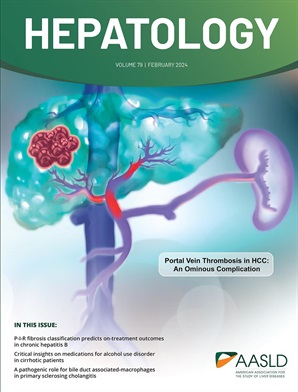Reprogramming macrophages to treat liver diseases
IF 12.9
1区 医学
Q1 GASTROENTEROLOGY & HEPATOLOGY
引用次数: 0
Abstract
Cutting-edge research has expanded our understanding of the macrophage activation programs in liver diseases making this immune cell type a therapeutic target. Clinical data on macrophage infiltration and polarization states have been used to help predict mortality or poor prognosis in patients with liver cirrhosis and/or hepatocellular carcinoma. The latest single-cell and spatial transcriptomics studies have dissected unforeseen aspects depicting the immense heterogeneity of macrophages and their multifaceted role on both promoting and resolving hepatic inflammation, injury, and fibrosis. Hepatic macrophages (resident tissue Kupffer cells and monocyte-derived macrophages) display such plasticity and phenotypic diversity that macrophages with antagonistic functions may coexist in adjacent regions of the liver. In this scenario, the analysis of macrophage-derived inflammatory and anti-inflammatory circulating soluble markers in patients with liver disease only offers a partial picture of the full complexity of the hepatic macrophage subsets. The reprogramming of macrophages involves understanding the multiple regulatory mechanisms and diverse populations of hepatic macrophages and the design of macrophage-targeted therapeutic interventions to restore hepatic homeostasis. Here we review the potential targets to modulate macrophage behavior in liver diseases and nanoscale therapeutics that aim to target and treat macrophages. We will summarize current knowledge on the diverse macrophage programs activated in chronic liver inflammation, cirrhosis and hepatocellular carcinoma that may be of therapeutic interest for precision medicine.重编程巨噬细胞以治疗肝病
前沿研究拓展了我们对肝病中巨噬细胞活化程序的了解,使这种免疫细胞类型成为治疗目标。有关巨噬细胞浸润和极化状态的临床数据已被用于帮助预测肝硬化和/或肝细胞癌患者的死亡率或不良预后。最新的单细胞和空间转录组学研究对巨噬细胞的巨大异质性及其在促进和解决肝脏炎症、损伤和纤维化方面的多方面作用进行了剖析。肝巨噬细胞(常驻组织 Kupffer 细胞和来源于单核细胞的巨噬细胞)具有可塑性和表型多样性,具有拮抗功能的巨噬细胞可能在肝脏的相邻区域共存。在这种情况下,对肝病患者体内巨噬细胞衍生的炎性和抗炎性循环可溶性标记物的分析只能部分反映肝脏巨噬细胞亚群的全部复杂性。巨噬细胞的重编程涉及了解肝巨噬细胞的多种调控机制和不同种群,以及设计以巨噬细胞为靶点的治疗干预措施以恢复肝平衡。在此,我们回顾了调节肝病中巨噬细胞行为的潜在靶点,以及旨在靶向和治疗巨噬细胞的纳米级疗法。我们将总结目前有关慢性肝脏炎症、肝硬化和肝细胞癌中激活的巨噬细胞程序的各种知识,这些程序可能对精准医疗具有治疗意义。
本文章由计算机程序翻译,如有差异,请以英文原文为准。
求助全文
约1分钟内获得全文
求助全文
来源期刊

Hepatology
医学-胃肠肝病学
CiteScore
27.50
自引率
3.70%
发文量
609
审稿时长
1 months
期刊介绍:
HEPATOLOGY is recognized as the leading publication in the field of liver disease. It features original, peer-reviewed articles covering various aspects of liver structure, function, and disease. The journal's distinguished Editorial Board carefully selects the best articles each month, focusing on topics including immunology, chronic hepatitis, viral hepatitis, cirrhosis, genetic and metabolic liver diseases, liver cancer, and drug metabolism.
 求助内容:
求助内容: 应助结果提醒方式:
应助结果提醒方式:


